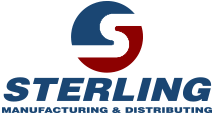At Sterling Manufacturing, we’ve been at the forefront of foam fabrication for over 50 years, serving a wide array of industries with our custom foam solutions.
As a leading foam fabricator based in Houston, Texas, we understand that choosing the right type of foam for your specific application can be crucial to your project’s success.
“The development of foam packing has been characterized by an ongoing search for innovation to satisfy changing industry demands,” says a research report released in May 2024. “The market has seen a radical shift from conventional Styrofoam blocks to custom-molded foam inserts, propelled by developments in material science and production technology.”
In this article, we’ll dive into the various foam options available and explore their unique properties and applications.
The Critical Role of Foam in the Global Supply Chain
Before we delve into specific foam types, it’s essential to understand the pivotal role that foam plays in the world’s supply chain.
Foam materials have become an indispensable component in numerous industries, significantly impacting how products are manufactured, packaged, and transported.
In fact, the global foam packaging market is projected to almost double in value between 2023 and 2031, going from $18.32 billion to $29.28 billion.
Key contributions of foam to the global supply chain:
- Product Protection: Foam packaging ensures that delicate items, from electronics to glassware, arrive at their destination undamaged. This reduces waste, minimizes returns, and enhances customer satisfaction.
- Weight Reduction: The lightweight nature of foam materials helps reduce shipping costs and fuel consumption in transportation, contributing to more efficient and environmentally friendly logistics.
- Customization: The versatility of foam allows for custom-designed packaging solutions, optimizing space utilization in shipping containers and warehouses.
- Insulation: Foam’s thermal insulation properties are crucial for temperature-sensitive products in industries like pharmaceuticals and food distribution.
- Shock Absorption: In industries such as automotive and electronics, foam components play a vital role in absorbing vibrations and impacts, ensuring product longevity and safety.
- Sustainability: Many foam materials can be recycled or reused, aligning with the growing demand for sustainable supply chain practices.
From the factory floor to the end consumer’s hands, foam materials are integral to maintaining the integrity and efficiency of global supply chains. As we explore different foam types, keep in mind how each contributes to this larger picture of worldwide product distribution and protection.
Polyurethane Foam (PU): The Versatile Wonder
Polyurethane foam is a true jack-of-all-trades in the world of foam materials.
The polyurethane Sterling supply’s, primarily Ether and Ester, is an open-cell foam that is available in various densities and colors for your unique applications. In addition to the standard foam, we also offer specialty foams like anti-static and anti-abrasive for specific applications.
At Sterling Manufacturing, we specialize in two main types of PU foam: Ether and Ester.
- Ether Foam: Ether foam is ubiquitous in our daily lives, finding its way into numerous products and applications. Here’s what you need to know about this versatile foam:
- Properties and characteristics:
- Open-cell structure.
- Available in various densities and colors.
- Can be modified for specific applications (e.g., colored, reticulated, static dissipative).
- Offers varying physical properties such as compression resistance, elongation, and tear strength.
- Common applications:
- Bedding and furniture manufacturing.
- Automotive components.
- Carpet underlay.
- Medical applications.
- Protective packaging.
- Properties and characteristics:
- Ester Foam: While similar in appearance to Ether foam, Ester foam boasts superior properties in several aspects:
- Properties and characteristics:
- Higher strength and stretch properties compared to Ether foam.
- Greater abrasion resistance.
- More resistant to degradation from exposure to alcohols and hydrocarbons.
- Hydrolysable (not suitable for high-humidity or wet environments).
- Typically, firmer than Ether foams of the same density.
- Common applications:
- Medical and acoustical applications
- Gasketing and sealing
- Fashion accessories and clothing
- Cosmetic industry (make-up sponges)
- Filtration systems
- Properties and characteristics:
Expandable Polystyrene (EPS): Lightweight and Rigid
EPS foam is a versatile material known for its lightweight and rigid properties. EPS foams are easily fabricated into shapes for protective packaging.
Let’s explore what makes this foam unique:
- Properties and characteristics:
- Lightweight and rigid structure.
- Density ranges from 0.7 lb/ft³ to 3 lb/ft³.
- Composed of small, expanded beads welded together.
- Compression resistance values ranging from 5 PSI to 60 PSI.
- Moisture-proof.
- Common applications:
- Packaging dunnage.
- Floatation devices.
- Insulation.
- Geofoam for construction and architectural applications.
- Concrete forming and void filling.
- Stage props and architectural elements (e.g., crown molding, columns)
Polyethylene (PE): The Packaging Powerhouse
Polyethylene foam is a go-to material for the packaging industry, offering excellent protection for a wide range of products. Considered the workhorse of the packaging industry, there are several types of PE foam available, manufactured in various ways.
Types include extruded (full sheet manufactured in one piece no matter the thickness) and laminated (desired thickness by layering several sheets of half or one-inch pieces together).
- Properties and characteristics:
- Available in extruded and laminated styles.
- Density ranges from 0.7 lb/ft³ to 9 lb/ft³.
- Cushions static loads from 0.3 PSI to 6+ PSI.
- Available in roll stock for thicknesses up to 1/2″.
- Common applications:
- Electronic packaging (computers, circuit boards, printers, monitors).
- Interleaving material for fragile items (glassware, dishes).
- Cushion packaging for painted or polished surfaces.
- Support cradles for cylindrical products.
- General protective packaging.
Comparison Table of Foam Types
| Foam Type | Density Range (lb/ft³) | Key Properties | Best For |
| PU Ether | Varies | Versatile, open-cell structure | Furniture, bedding, automotive |
| PU Ester | 1.3 – 6 | High strength, abrasion-resistant | Medical, acoustical, filtration |
| EPS | 0.7 – 3 | Lightweight, rigid, moisture-proof | Packaging, insulation, construction |
| PE | 0.7 – 9 | Excellent cushioning, non-abrasive | Packaging, electronics protection |
Specialty Applications: Foam Cubes
While not a distinct foam type, foam cubes deserve special mention due to their unique applications in recreational and sporting facilities. At Sterling Manufacturing, we offer a range of vibrant, high-quality foam cubes perfect for:
- Gymnastics facilities.
- Trampoline parks.
- Recreational areas.
Our foam cubes are:
- Available in a variety of vivid colors.
- Kid-tested and approved for all ages.
- Customizable to match your branding or preferences.
- Complemented by our range of landing mats and protective pads
Sterling Manufacturing: Experts in Foam Fabrication
The world of foam is vast and varied, with each type offering unique properties suited to different applications. At Sterling Manufacturing, we pride ourselves on our expertise in foam fabrication and our ability to recommend the perfect foam solution for your specific needs.
Whether you’re in the furniture industry, packaging sector, or building a state-of-the-art recreational facility, we have the knowledge and resources to support your project from concept to completion.
Ready to explore the perfect foam solution for your next project?
Contact us today at 713-695-5333 or visit our website to discuss your foam requirements.


